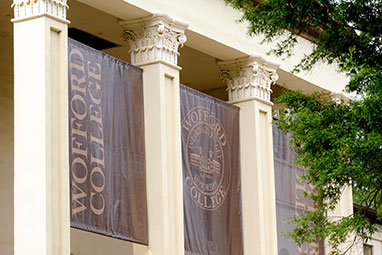SPARTANBURG, S.C. – The New York Times this week ranked Wofford College among the 99 “most economically diverse top colleges,” based on efforts to provide low-income students accessibility to a college education. Wofford was the top South Carolina institution on the list, ranked at 43rd, just ahead of Yale University at 44 and Davidson College at 47.
In his “The Upshot” blog published this week, writer David Leonhardt focused on how economic diversity has changed at top colleges and universities, using data on first-time, full-time students with Pell grants from 2008 to the present.
Wofford scores above the overall average on the list and is one of only six institutions that posted a double-digit increase in the percentage of Pell-eligible students.
“On the key issues that most concern families when it comes to higher education – access, diversity, quality and completion – our place among the most prestigious universities and colleges in the country is evident,” Wofford President Nayef H. Samhat says. “Wofford’s extraordinary and transformational educational experience is accessible, socio-economically diverse, and we graduate superior students in four years.”
Leonhardt writes: “Over the last decade, dozens of colleges have proclaimed that recruiting a more economically diverse student body was a top priority. Many of those colleges have not matched their words with actions. But some have.
“These colleges have changed policies and made compromises elsewhere to recruit the kind of talented poor students who have traditionally excelled in high school but not gone to top colleges,” he continues. “A surprising number of such students never graduate from any college.”
Leonhardt explains that to see which selective colleges are doing the most, and the least, to “change the situation,” he analyzed data for every college with a four-year graduation rate of at least 75 percent. “We combined data on enrollment and tuition costs to measure how hard each college is trying to attract and graduate poor and middle-class students. The result is our College Access Index.”
Carolyn B. Sparks, director of financial aid at Wofford, says, “As a whole, Wofford seeks diversity in many realms. Our strategic enrollment plan addresses the desire to attract Pell-eligible students by offering institutional need-based and possibly merit aid, as well as other federal and state funds, which can make a student’s aid package more attractive and affordable. The plan also encompasses other areas of diversity, such as geographic, ethnic or racial, and international.”
Sparks adds that because scholarship dollars are limited, “the need to effectively spread those funds is necessary. Another consideration is the fact that we have other areas of diversity in the mix of our enrollment plan, so ‘stretching’ our scholarships is imperative.”
Read the full article at http://www.nytimes.com/2014/09/09/upshot/top-colleges-that-enroll-rich-middle-class-and-poor.html?abt=0002&abg=0 (registration may be required)
